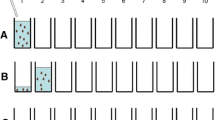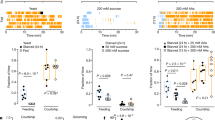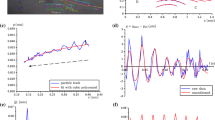Abstract
We present a novel approach for examining the complex feeding behavior of a filter feeder at a previously unexploited scale. A Daphnia lives in a viscous environment and thus creates a feeding current with a distinct laminar inflow and a repetitive pulsed outflow. We propose that by treating the feeding apparatus as a black box, and using the pulsed outflow current as a surrogate to the inside working of the apparatus, we can calculate feeding rate in near real time. The structure of the outflow is interpreted as a direct representation of the organism’s response to its environment. Therefore, we examine how the work performed by an organism’s feeding apparatus is altered according to environmental factors and metabolic demands. Our approach is an integration of optical (Schlieren system) and electrochemical (chronoamperometry) techniques that allow for real time visualization and temporal analysis of flow systems, respectively. As electrochemistry requires a tracer chemical, we employed low dopamine concentrations (≤ 1mM), and tested the effect of dopamine on the heart rate and swimming of Daphnia. It appears that dopamine free in solution at concentrations below 10 mM has no adverse effects on the organism, and all observed differences in Daphnia feeding behavior were due to environmental or metabolic factors. The feeding nature of daphnids in the presence or absence of food, and differences between the sexes is reported. Our results indicate that in the absence of food a Daphnia has a strict and repetitive feeding behavior with short delays between pumping actions. However, in the presence of food this behavior becomes complex, with increased delays between pumps, perhaps designed to maximize feeding efficiency. Our observations demonstrate that males have a higher appendage beat frequency than females under identical conditions. We hypothesize that the difference may be dictated by metabolic demand, as a male spends more time actively seeking a mate. The application of electrochemistry to the study of Daphnia feeding behavior is an improvement over current methods for its near real time quantification of behavioral response, its versatile application under varying environmental conditions and its extreme sensitivity to changes in the organism’s feeding behavior. This technique is a valuable addition to the current tools available for studying Daphnia feeding behavior and will allow us to learn more about the interactions of an organism with its environment.







Similar content being viewed by others
References
Baumer, C., R. Pirow & R. J. Paul, 2002. Circulatory oxygen transport in the water flea Daphnia magna. Journal of Comparative Physiology B-Biochemical Systemic and Environmental Physiology 172: 275–285.
Baur, J. E., E. W. Kristensen, L. J. May, D. J. Wiedemann & R. M. Wightman, 1988. Fast-scan voltammetry of biogenic-amines. Analytical Chemistry 60: 1268–1272.
Blenau, W. & A. Baumann, 2001. Molecular and pharmacological properties of insect biogenic amine receptors: Lessons from Drosophila melanogaster and Apis mellifera. Archives of Insect Biochemistry and Physiology 48: 13–38.
Brewer, M. C., 1998. Mating behaviours of Daphnia pulicaria, a cyclic parthenogen: comparisons with copepods. Philosophical Transactions of the Royal Society of London B 353: 805–815.
Burns, C. W., 1968. Direct observations of mechanisms regulating feeding behaviour of Daphnia in lakewater. Internationale Revue der gesamten Hydrobiologie 53: 83–100.
Cannon, G., 1928. On the feeding mechanism of the copepods, Calanus finmarchicus and Diaptomus gracilis. British Journal of Experimental Biology 6: 131–144.
Colmorgen, M. & R. J. Paul, 1995. Imaging of physiological functions in transparent animals (Agonus cataphractus, Daphnia magna, Pholcus phalangioides) by video microscopy and digital image-processing. Comparative Biochemistry and Physiology a-Physiology 111: 583–595.
Darchambeau, F. & I. Thys, 2005. In situ filtration responses of Daphnia galeata to changes in food quality. Journal of Plankton Research 27: 227–236.
Demott, W. R. & S. A. Schoenberg, 1988. Discrimination between algae and artificial particles by fresh-water and marine copepods. Limnology and Oceanography 33: 397–408.
Dodson, S. I. & D. Frey, 1991. Cladocera and other Branchiopoda. In Thorpe, J. H. & A. P. Covich (eds), Ecology and Classification of North American freshwater Invertebrates. Academic Press, New York, 723–786.
Fryer, G., 1987. The feeding mechanisms of the Daphniidae (Crsutacea: Cladocera): recent suggestions and neglected considerations. Journal of Plankton Research 9: 419–432.
Gerhardt, G. A. R., G. M. Rose & B. J. Hoffer, 1987. In vivo electrochemical demonstration of potassium-evoked monoamine release from the rat cerebellum. Brain Research 413: 327–335.
Gerritsen, J., K. Porter & J. R. Strickler, 1988. Not by sieving alone—Observations of suspension feeding in Daphnia. Bulletin of Marine Science 43: 366–376.
Ghadouani, A., B. Pinel-Alloul, K. Plath, G. Codd & W. Lampert, 2004. Effects of Microcystis aeruginosa and purified microcystin-LR on the feeding behavior of Daphnia pulicaria. Limnology and Oceanography 49: 666–679.
Guckenheimer, J., & P. Holmes, 1983. Nonlinear Oscillations, Dynamical Systems, and Bifurcations of Vector Fields. Springer-Verlag.
Haney, J., J. Sasner & M. Ikawa, 1995. Effects of products released by Aphanizomenon flos-aquae and purified saxitoxin on the movement of Daphnia carinata feeding appendages. Limnology and Oceanography 40: 263–272.
Keller, T. A., A. M. Tomba & P. A. Moore, 2001. Orientation in complex chemical landscapes: spatial arrangement of chemical sources influences crayfish food-finding efficiency in artificial streams. Limnology and Oceanography 46: 238–247.
Kerfoot, C. & K. Kirk, 1991. Degree of taste discrimination among suspension-feeding cladocerans and copepods: Implications for detritivory and herbivory. Limnology and Oceanography 36: 1107–1123.
Kmet, T. & M. Straskraba, 2004. Feeding adaptations of filter feeders: Daphnia. Ecological Modelling 178: 313–327.
Kuhr, W. & R. Wightman, 1986. Real time measurement of dopamine release in rat-brain. Brain Research 381: 168–171.
Lampert, W., 1987. Feeding and Nutrition in Daphnia. In Peters, R. H. & R. De Bernardi (eds), Daphnia. Instituto Italiano di Idrobiologia, Italy, 143–192. .
Lampert, W. & H. Brendelberger, 1996. Strategies of phenotypic low-food adaptation in Daphnia: Filter screens, mesh size, and appendage beat rate. Limnology and Oceanography 41: 216–223.
Moore, P., G. Gerhardt & J. Atema, 1989. High resolution spatio - temporal analysis of aquatic chemical signals using microelectrochemical electrodes. Chemical Senses 14: 829–840.
Moore, P. A., J. Atema & G. A. Gerhardt, 1991. Fluid-dynamics and microscale chemical movement in the chemosensory appendages of the lobster, Homarus-Americanus. Chemical Senses 16: 663–674.
Mustard, J. A., K. T. Beggs & A. R. Mercer, 2005. Molecular biology of the invertebrate dopamine receptors. Archives of Insect Biochemistry and Physiology 59: 103–117.
Mustard, J. A., W. Blenau, I. S. Hamilton, V. K. Ward, P. R. Ebert & A. R. Mercer, 2003. Analysis of two D1-like dopamine receptors from the honeybee Apis mellifera reveals agonist-independent activity. Molecular Brain Research 113: 67–77.
Plath, K., 1998. Adaptive feeding behavior of Daphnia magna in response to short term starvation. Limnology and Oceanography 43: 593–599.
Porter, K., J. Gerritsen & J. Orcutt Jr., 1982. The effects of food concentration on swimming patterns, feeding behavior, ingestion, assimilation, and respiration of Daphnia. Limnology and Oceanography 27: 935–949.
Rudiger, J., M. Colmorgen, S. Huller, F. Tyroller & D. Zinkler, 1997. Circulation and respiratory control in millimetre-sized animals (Daphnia magna, Folsomia candida) studied by optical methods. Journal of Comparative Physiology B-Biochemical Systemic and Environmental Physiology 167: 399–408.
Scheiner, R., S. Pluckhahn, B. Oney, W. Blenau & J. Erber, 2002. Behavioral pharmacology of octopamine, tyramine, and dopamine in honeybees. Behavioural Brain Research 136: 545–553.
Schneider, R. W. S., B. A. Price & P. A. Moore, 1998. Antennal morphology as a physical filter of olfaction: temporal tuning of the antennae of the honeybee, Apis mellifera. Journal of Insect Physiology 44: 677–684.
Skoog, D. A., F. Holler & T. A. Neiman, 1998. Principles of Instrumental Analysis. Saunders College Publications, Philadelphia.
Spicer, J. I. & D. Morritt, 1996. Ontogenic changes in cardiac function in Crustaceans. Comparative Biochemistry and Physiology a-Physiology 114: 81–89.
Strickler, J. R. & J. Hwang, 1999. Matched spatial filters in long working distance microscopy of phase objects. In Cheng, P.C., P.P. Hwang, J.L. Wu, G. Wang & H. Kim (eds), Focus on Multidimensional Microscopy. World Scientific Publishing Pte. Ltd., River Edge, NJ, 217–239.
Vogel, S., 1994. Life in Moving Fluids: the Physical Biology of Flow. Princeton University Press, Princeton, NJ.
Wang, R. & B. Wang, 2000. Phase space representation and characteristics of El Nino-La Nina. Journal of Atmospheric Science 57: 3315–3333.
Wightman, R., L. May & A. Michael, 1988. Detection of dopamine dynamics in the brain. Analytical Chemistry 60: 769A–779A.
Yen, J. & J. Strickler, 1996. Advertisement and concealment in the plankton: What makes a copepod hydrodynamically conspicuous? Invertebrate Biology 115: 191–205.
Yule, A. & D. Crisp, 1983. A study of feeding behavior in Temora longicornus (Muller) (Crustacea, Copepoda). Journal of Experimental Marine Biology and Ecology 71: 271–282.
Acknowledgments
This research was supported by a grant from The Center for Water Security and US-EPA. D.C.P.-A. gratefully acknowledges receipt of an USEPA GRO Fellowship, and would like to thank Dr. John Baur for his support and guidance in constructing microelectrodes, Ai Nihongi for her support in the preliminary workings of this system, and Dr. Peter Dunn for his statistical expertise. She would also like to thank Drs. S. Dodson, R. Klapper, plus K. Forshay, and J. Barker for their editing and proofreading of this manuscript. Finally, this article is dedicated to the memory of, Dinorah Arana de Peñalva, Ms. Peñalva-Arana’s mother.
Author information
Authors and Affiliations
Corresponding author
Additional information
Guest editor: Piet Spaak
Cladocera: Proceedings of the 7th International Symposium on Cladocera
Rights and permissions
About this article
Cite this article
Peñalva-Arana, D.C., Moore, P.A., Feinberg, B.A. et al. Studying Daphnia feeding behavior as a black box: a novel electrochemical approach. Hydrobiologia 594, 153–163 (2007). https://doi.org/10.1007/s10750-007-9080-7
Published:
Issue Date:
DOI: https://doi.org/10.1007/s10750-007-9080-7




